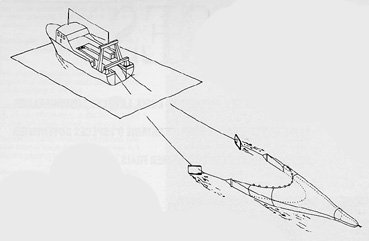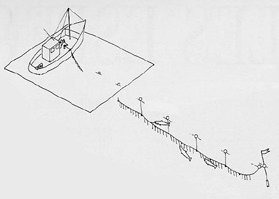Fishing methods for fish and shellfish
Professional fishing is made up of a multitude of different techniques. We'd like to introduce you to the specific features and benefits of each of them.
Trawling
The trawl net is an enormous conical net towed by a boat, the trawler, using funnels (metal cables). It can be used to catch a wide variety of species. At depth (bottom trawl), it catches fish such as monkfish, hake and cod. Between 2 waters (pelagic trawl), species such as tuna, sea bass or sardines are caught.
Net fishing
The net is a rectangular strip of mesh made up of one or more layers. It is placed vertically in the water to block the path of fish caught in its gills. To remain vertical, it is tensioned by floats on the upper edge and sinkers on the lower edge. The net may be floating if static, or drifting if towed by a boat. Depending on its height, color and mesh size, different species will be caught with the net.
Net fishing - Source Ifremer
Bolinche fishing
The bolinche is a special kind of net: it encircles schools of fish. The boat to which the bolinche is attached circles a shoal (sardines, anchovies) to capture it. A rope at the bottom of the net is then closed to create a pocket in which the fish are trapped. The seine is a bolinch used for larger species such as tuna.
Bolinche fishing - Source Ifremer
Angling
Lines are ropes with baited hooks suspended vertically. Line boats are responsible for raising them. A variant of line fishing is fishing with rods aboard the boat. This latter technique is often used for tuna fishing.
Angling - Source Ifremer
Troll fishing
Troll fishing uses lines towed behind a boat. This technique is used close to the surface and between 2 waters.
Longline fishing
La palangrier est un bateau permettant de pêcher à la ligne plusieurs poissons. La raie, le congre, la dorade, le grondin et le merlan sont par exemple capturés avec une palangre de fond alors que le bar, le thon et l’espadon sont pêchés avec une palangre flottante.
La palangre est composée d’une ligne principale sur laquelle est fixé des avançons* avec des hameçons appâtés. Elle est déployée entre deux bouées, laissée sur place pendant quelques heures, puis relevé par le palangrier.
*Un avançon est un morceau de ligne entre le fil de pêche et l’hameçon.
Longline fishing - Source Ifremer
Net fishing
The creel technique is used along the coast to catch crustaceans. The creel is made of a frame covered with mesh. It is weighted with stones to keep it on the bottom and contains bait fixed inside. Once inside, the animal is trapped and cannot get out. To prevent the trap from getting lost, it is attached to a float by a rope. They are regularly lifted by caseyeurs.
Net fishing - Source Ifremer
Dredge fishing
The dredge is a metal structure that scrapes the seabed to catch shellfish and burrowing fish.
All these techniques are specific to a given depth and therefore to a given species:

Techniques de pêche en fonction de la profondeur - Source Ifremer






